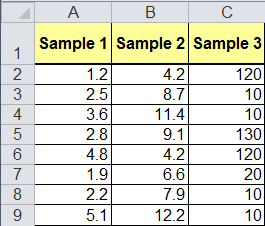

This function corresponds to the transform of a continuous time series. The spectral density is a function that can be interpreted as the covariance of the time signal. From there we can obtain decomposition the autocovariance and autocorrelation functions into sinusoids.
#Running a statistical analysis in excel series#
The spectral representation of a time series Xt, (t=1,…,n), decomposes Xt into a sum of sinusoidal components with uncorrelated random coefficients. Spectral analysis is a very general method used in a variety of domains. By studying the spectral density, seasonal components and/or noise can be identified.

It is then possible to build representations such as the periodogram or the spectral density, and to test if the series is stationary. The magnitude and phase can be extracted from the coordinates. Spectral analysis allows transforming a time series (time signal) into its coordinates in the space of frequencies, and then to analyze its characteristics in this space. Select date data and run the analysis for one to several time series.Display the spectral density and the periodogram.Calculate the cross spectrum (quadrature spectrum.Estimate the spectral density by choosing one of several kernel types.Test if your time series (signal) is a white noise.XLSTAT provides a complete Spectral analysis feature, which enables several options that will let you gain a deep insight on your data: Spectral analysis is a powerful time series analysis method that lets you describe your data that is in the time domain, in the frequency domain.


 0 kommentar(er)
0 kommentar(er)
